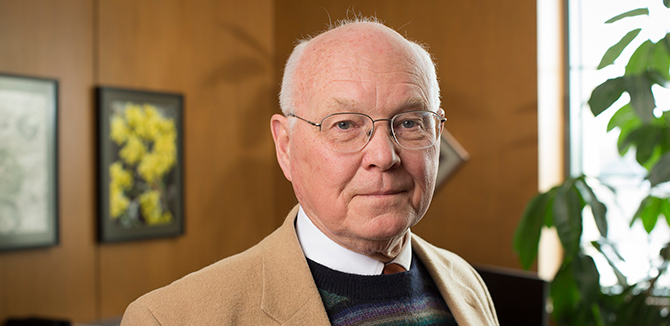Stephen Carr Looks Back on Impactful Career
Carr became a professor emeritus in January
Stephen Carr doesn’t have to look far to see his influence — even though his impact can be felt well beyond Northwestern Engineering.
Carr retired in January, becoming professor emeritus of materials science and engineering and chemical and biological engineering. He served as senior associate dean for undergraduate engineering at the McCormick School of Engineering from 1992 to 2015. Over those 23 years, Carr helped revamp the curriculum, shepherding Engineering First, an overhaul of the undergraduate curriculum to embrace design thinking. That was the beginning of creating the culture that would eventually be called whole-brain engineering.
“It has franchised the whole notion that design thinking is really at the intellectual heart of anybody who’s a true engineer — a person who can translate insights from science and mathematics, new things, and then come up with a way to create something that never existed before,” Carr said. “I think that’s what I did, and I’m proud of that.”
Carr’s legacy at Northwestern Engineering extends to his important scientific contributions.
Upon arriving in Evanston in 1970 after receiving his PhD in polymer science from Case Western Reserve University, Carr started at Northwestern as assistant professor in the materials science and engineering and chemical and biological engineering departments. Carr rose to associate professor in 1973, and professor in 1978. He also served as the director of the Materials Research Center from 1984 to 1990, and as co-director of the Master of Product Design and Development Management program from 2015-2020.
His research focused on polymeric materials in widely varying contexts, ranging from biopolymers to electro-optically active polymers to structural polymers. Carr saw the effect of his work in two very different places.
Back in the 1990s, General Motors began putting sheet molding compound (SMC) into their cars to replace steel parts. A ready-to-mold glass-fiber reinforced polyester material, SMC can be made into sheets and stamped. And like steel, it can be shaped and painted but is lighter in weight.
Carr served as a research consultant to the Big Three automaker, and along with two colleagues, helped push SMC forward. The biggest obstacle, Carr said, wasn’t producing SMC but convincing auto makers and consumers that cars didn’t need to be made with steel, but with more plastic.
Around five years into the company’s use of SMC, Carr bought a Chevrolet Lumina with an SMC exterior, using many components he helped develop.
Carr asked the salesperson at the dealership whether any customer who was interested in making a purchase was turned off by the lack of steel.
“The salesman said, ‘I didn’t know it wasn’t made out of steel and the customers don’t either,’” Carr recalled.
Carr has also seen his work used by a much more secretive organization.
For almost 20 years, Carr served as chairman of the University faculty committee that oversees the Northwestern Naval Reserve Officer’s Training Corps (ROTC) unit. Two years ago, a representative of the Pentagon invited Carr to a three-day visit in San Diego to see the city’s naval installations.
At 5:15 a.m., Carr reported, and was driven to a dock with nuclear submarines. During the 12-hour trip, Carr climbed the sail – the large structure atop the boat – when the vessel surfaced and was about 40 feet above the water. Looking at the submarine’s hull, Carr saw a long ridge along one side of the vessel. The ridge was the towed array: an assortment of microphones pulled behind a sub with a 10-kilometer wire that goes up and down the ship in a tube that runs along the vessel. Every 100 feet is a microphone that sends back signals.
Carr realized the microphones are made of a piezoelectric plastic he helped develop.
“I saw that deployed on a submarine,” Carr said. “That was quite the sight.”

